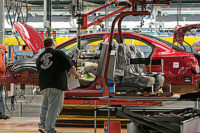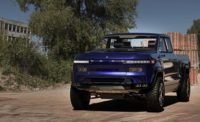Automotive assembly lines have operated the same way for a century. Each worker takes charge of a single process and installs parts in vehicles as they move on a chain-driven or skillet conveyor.
Honda Motor Co. engineers have come up with an innovative alternative that incorporates a flowing-cell production system. The assembly revolution cell (ARC) line consists of a moving conveyor unit that carries one vehicle and a complete set of sequenced parts. Four assemblers step aboard each platform and ride around the U-shaped cell until a vehicle is assembled.
Honda recently deployed the ARC trim line at its new plant in Prachinburi, Thailand, which builds the Civic sedan. According to the automaker, the goal is to “deliver quality products with the optimal balance of human craftsmanship and advanced production technologies.”
“This system reduces any incidental movements by production associates, such as selecting the proper parts for the specifications of the next body coming down the line and installing them while walking along with the body,” says a Honda spokesperson. “These are not considered essential assembly movements, but are inevitable in conventional production processes.”
The ARC line achieves a significant improvement in production efficiency. Each operator takes charge of a wide range of assembly processes, which enables him to perform a broader range of production tasks.
Honda claims that its new conveyor boosts assembly line efficiency by 10 percent. At the same time, it also reduces material handling by 10 percent.
“Because of the loop-shape of the conveyor, supplying full boxes of parts at the start of assembly and retrieving empty boxes at the end of assembly can be done at the same spot,” explains a Honda spokesperson. “As a result, the number of spots where parts are brought to the line is minimized, which reduces the workload.”
The new assembly line currently consists of 50 platform conveyor units. Each unit is made up of one circular platform and one rectangular platform, which are each equipped with wheels underneath. Vehicles ride on the rectangular platforms.
The surface of the motor-driven, articulated platforms is covered with wood. The wide platform enables operators to access parts and components that are positioned in close proximity to each vehicle.
Assemblers install wiring harnesses, interior trim components and exterior parts using battery-powered fastening tools. Each operator is equipped with a tablet device that contains paperless work instructions and error-proofing software.
The number of platforms and cells can be increased or decreased to adjust the assembly line’s length and configuration. That flexibility will allow Honda engineers to alter the layout of the line to accommodate future changes in production volume or models. Honda claims that ARC was cheaper to install than traditional automotive assembly lines.
“Since it is a floor-based conveyor, there was no need to excavate the plant floor,” says a Honda spokesperson. “Also, the ARC line does not require an overhead conveyor. Therefore, there are less structural conditions required to build a plant.”
“This configuration looks promising, because it’s inherently flexible,” says Mike Jackson, senior executive for vehicle production forecasting at IHS Automotive. “Any element of efficiency is going to help on the competitive front.”
However, other industry observers are more skeptical and question Honda’s production strategy.
“This concept is not new,” claims Sandy Munro, CEO of Munro & Associates Inc., a lean design consulting firm. “Volvo spent a fortune on this type of system [40 years ago] and basically invented the AGV system to try to accomplish the same thing as Honda. General Motors tried the Volvo system on the GMT 400 truck program in Oshawa, ON.
“Everyone is always looking for something new and exciting, and everyone loves to run after the Japanese lead,” adds Munro, who believes the ARC concept will have trouble catching on in the auto industry.
“I can’t imagine the preventive maintenance needed to keep this monster going,” says Munro. “A master mechanic at every pallet is impossible; any sort of volume production impossible; accurate, consistent rundown unlikely; investment cost out of this world; and kitting will be a nightmare, unless they have even less SKUs than normal.”




